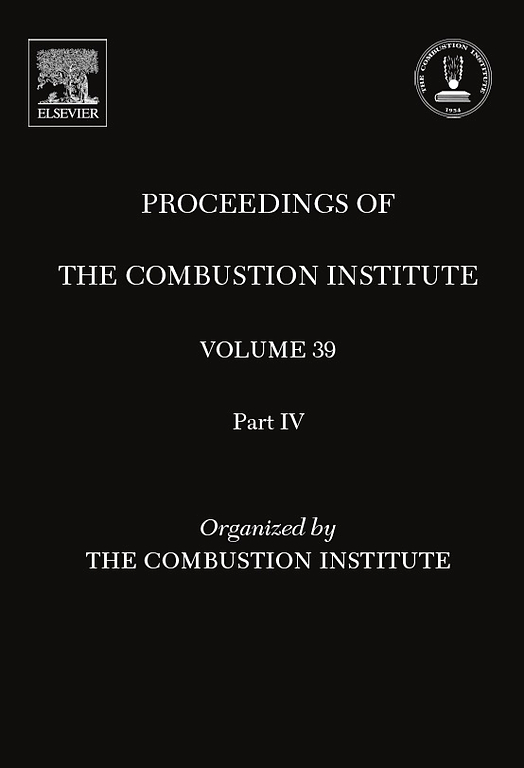空气分层和热损失对 NH3/CH4/air 旋转火焰 NO 排放的影响
IF 5.3
2区 工程技术
Q2 ENERGY & FUELS
引用次数: 0
摘要
在碳中和的背景下,氨(NH)被认为是一种前景广阔的无碳燃料。然而,NH 旋转火焰的排放特性受热损失和燃料分级的影响很大。本研究调查了空气分级漩涡燃烧器中 NH/CH/ 空气混合物的氮氧化物排放情况。氨的摩尔分数从 = 0.3、0.6 到 1.0 不等,一次当量比和总当量比分别从 = 0.7 到 1.7 和 = 0.5 到 0.7 不等。为了区分热效应和化学效应对 NO 排放的影响,采用了四种不同的二次空气喷射策略和三种热损失率。O 、NO 和 CO 的排放是通过烟气分析仪测量的。火焰内温度由细线热电偶测量,化学发光(OH*、NH*)由增强型 CCD 相机捕捉。化学反应器网络法用于模拟两级燃烧。二次气体注入最初会产生热效应,冷却贫气侧的下游火焰温度。在 = 1.3 后,化学效应占主导地位,而火焰则面临升空不稳定性的挑战。 = 1.3 显示了最低的 NO 排放,而 = 1.1、= 0.7 的冷却则显示了较低的 NO 水平和较高的火焰稳定性。大于 1.3 的火焰倾向于升空并与二次空气合并,从而降低了空气分级效果。NH* 和 OH* 表示火焰腾空和二次火焰形成。模拟结果表明,在一级冷却条件下,有利于去除 NO,而在二级隔热条件下,抑制了 NO 的产生。为确保低 NO 排放、氨完全氧化和火焰稳定性,将一级火焰区稳定在 = 1.0 附近,将总当量比稳定在 = 0.7 附近,并结合冷却策略是有效的。本文章由计算机程序翻译,如有差异,请以英文原文为准。
Effects of air-staging and heat losses on NO emissions of NH3/CH4/air swirling flames
Ammonia (NH) is considered a promising carbon-free fuel in the context of carbon neutrality. However, the emission characteristics of NH swirling flames respond strongly to the influence of heat loss and fuel staging. This study investigated the NO emissions of NH/CH/air mixtures in an air-staging swirling combustor. The ammonia mole fractions range from = 0.3, 0.6, to 1.0, with the primary and overall equivalence ratios ranging from = 0.7 to 1.7 and = 0.5 to 0.7, respectively. Four different secondary air injection strategies and three heat losses rates were adopted to differentiate the thermal and chemical effects on NO emissions. O, NO, and CO emissions were measured using a flue gas analyzer. In-flame temperature was measured by fine-wire thermocouples, and chemiluminescence (OH*, NH*) was captured by an intensified CCD camera. The chemical reactor network approach was used to simulate the two-stage combustion. Secondary gas injection initially has a thermal effect by cooling the downstream flame temperature on the lean side. After = 1.3, the chemical effect dominated while the flame was challenged by lift-off instability. = 1.3 showed the minimum NO emission, while = 1.1, = 0.7 with cooling exhibited low NO levels and high flame stability. Flame at > 1.3 tended to lift-off and merge with secondary air, diminishing the air-staging effect. NH* and OH* indicate the flame lift-off and secondary flame formation. Simulation results show that NO removal is favored at cooling conditions in the primary stage and NO production is suppressed at thermal-insulation conditions in the secondary stage. To ensure low NO emissions, complete ammonia oxidation, and flame stability, stabilizing the primary flame zone close to = 1.0 and overall equivalence ratio close to = 0.7 in combination with the cooling strategy is effective.
求助全文
通过发布文献求助,成功后即可免费获取论文全文。
去求助
来源期刊

Proceedings of the Combustion Institute
工程技术-工程:化工
CiteScore
7.00
自引率
0.00%
发文量
420
审稿时长
3.0 months
期刊介绍:
The Proceedings of the Combustion Institute contains forefront contributions in fundamentals and applications of combustion science. For more than 50 years, the Combustion Institute has served as the peak international society for dissemination of scientific and technical research in the combustion field. In addition to author submissions, the Proceedings of the Combustion Institute includes the Institute''s prestigious invited strategic and topical reviews that represent indispensable resources for emergent research in the field. All papers are subjected to rigorous peer review.
Research papers and invited topical reviews; Reaction Kinetics; Soot, PAH, and other large molecules; Diagnostics; Laminar Flames; Turbulent Flames; Heterogeneous Combustion; Spray and Droplet Combustion; Detonations, Explosions & Supersonic Combustion; Fire Research; Stationary Combustion Systems; IC Engine and Gas Turbine Combustion; New Technology Concepts
The electronic version of Proceedings of the Combustion Institute contains supplemental material such as reaction mechanisms, illustrating movies, and other data.
 求助内容:
求助内容: 应助结果提醒方式:
应助结果提醒方式:


